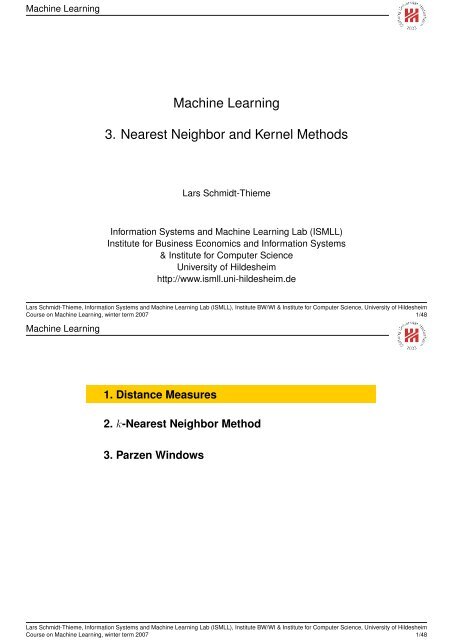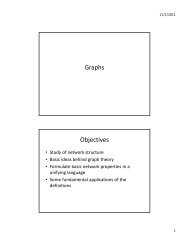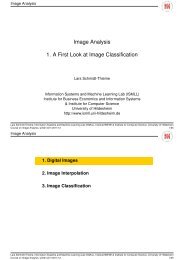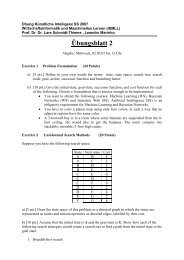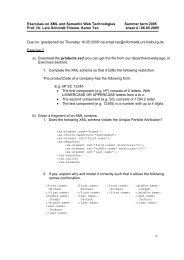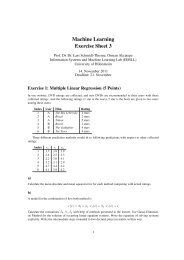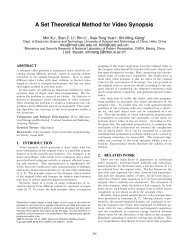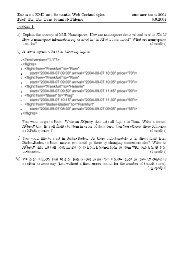Machine Learning 3. Nearest Neighbor and Kernel Methods - ISMLL
Machine Learning 3. Nearest Neighbor and Kernel Methods - ISMLL
Machine Learning 3. Nearest Neighbor and Kernel Methods - ISMLL
Create successful ePaper yourself
Turn your PDF publications into a flip-book with our unique Google optimized e-Paper software.
<strong>Machine</strong> <strong>Learning</strong><br />
<strong>Machine</strong> <strong>Learning</strong><br />
<strong>3.</strong> <strong>Nearest</strong> <strong>Neighbor</strong> <strong>and</strong> <strong>Kernel</strong> <strong>Methods</strong><br />
Lars Schmidt-Thieme<br />
Information Systems <strong>and</strong> <strong>Machine</strong> <strong>Learning</strong> Lab (<strong>ISMLL</strong>)<br />
Institute for Business Economics <strong>and</strong> Information Systems<br />
& Institute for Computer Science<br />
University of Hildesheim<br />
http://www.ismll.uni-hildesheim.de<br />
Lars Schmidt-Thieme, Information Systems <strong>and</strong> <strong>Machine</strong> <strong>Learning</strong> Lab (<strong>ISMLL</strong>), Institute BW/WI & Institute for Computer Science, University of Hildesheim<br />
Course on <strong>Machine</strong> <strong>Learning</strong>, winter term 2007 1/48<br />
<strong>Machine</strong> <strong>Learning</strong><br />
1. Distance Measures<br />
2. k-<strong>Nearest</strong> <strong>Neighbor</strong> Method<br />
<strong>3.</strong> Parzen Windows<br />
Lars Schmidt-Thieme, Information Systems <strong>and</strong> <strong>Machine</strong> <strong>Learning</strong> Lab (<strong>ISMLL</strong>), Institute BW/WI & Institute for Computer Science, University of Hildesheim<br />
Course on <strong>Machine</strong> <strong>Learning</strong>, winter term 2007 1/48
<strong>Machine</strong> <strong>Learning</strong> / 1. Distance Measures<br />
Motivation<br />
So far, regression <strong>and</strong> classification methods covered in the<br />
lecture can be used for<br />
• numerical variables,<br />
• binary variables (re-interpreted as numerical), <strong>and</strong><br />
• nominal variables (coded as set of binary indicator variables).<br />
Often one is also interested in more complex variables such as<br />
• set-valued variables,<br />
• sequence-valued variables (e.g., strings),<br />
• . . .<br />
Lars Schmidt-Thieme, Information Systems <strong>and</strong> <strong>Machine</strong> <strong>Learning</strong> Lab (<strong>ISMLL</strong>), Institute BW/WI & Institute for Computer Science, University of Hildesheim<br />
Course on <strong>Machine</strong> <strong>Learning</strong>, winter term 2007 1/48<br />
<strong>Machine</strong> <strong>Learning</strong> / 1. Distance Measures<br />
Motivation<br />
There are two kinds of approaches to deal with such variables:<br />
feature extraction:<br />
try to derive binary or numerical variables,<br />
then use st<strong>and</strong>ard methods on the feature vectors.<br />
kernel methods:<br />
try to establish a distance measure between two variables,<br />
then use methods that use only distances between objects<br />
(but no feature vectors).<br />
Lars Schmidt-Thieme, Information Systems <strong>and</strong> <strong>Machine</strong> <strong>Learning</strong> Lab (<strong>ISMLL</strong>), Institute BW/WI & Institute for Computer Science, University of Hildesheim<br />
Course on <strong>Machine</strong> <strong>Learning</strong>, winter term 2007 2/48
<strong>Machine</strong> <strong>Learning</strong> / 1. Distance Measures<br />
Distance measures<br />
Let d be a distance measure (also called metric) on a set X ,<br />
i.e.,<br />
d : X × X → R + 0<br />
with<br />
1. d is positiv definite: d(x, y) ≥ 0 <strong>and</strong> d(x, y) = 0 ⇔ x = y<br />
2. d is symmetric: d(x, y) = d(y, x)<br />
<strong>3.</strong> d is subadditive: d(x, z) ≤ d(x, y) + d(y, z)<br />
(triangle inequality)<br />
(for all x, y, z ∈ X .)<br />
Example: Euclidean metric on X := R n :<br />
n∑<br />
d(x, y) := ( (x i − y i ) 2 ) 2<br />
1<br />
i=1<br />
Lars Schmidt-Thieme, Information Systems <strong>and</strong> <strong>Machine</strong> <strong>Learning</strong> Lab (<strong>ISMLL</strong>), Institute BW/WI & Institute for Computer Science, University of Hildesheim<br />
Course on <strong>Machine</strong> <strong>Learning</strong>, winter term 2007 3/48<br />
<strong>Machine</strong> <strong>Learning</strong> / 1. Distance Measures<br />
Minkowski Metric / L p metric<br />
Minkowski Metric / L p metric on X := R n :<br />
n∑<br />
d(x, y) := ( |x i − y i | p ) p<br />
1<br />
with p ∈ R, p ≥ 1.<br />
i=1<br />
p = 1 (taxicab distance; Manhattan distance):<br />
n∑<br />
d(x, y) := |x i − y i |<br />
p = 2 (euclidean distance):<br />
d(x, y) := (<br />
i=1<br />
n∑<br />
(x i − y i ) 2 ) 2<br />
1<br />
p = ∞ (maximum distance; Chebyshev distance):<br />
d(x, y) :=<br />
i=1<br />
n<br />
max<br />
i=1 |x i − y i |<br />
Lars Schmidt-Thieme, Information Systems <strong>and</strong> <strong>Machine</strong> <strong>Learning</strong> Lab (<strong>ISMLL</strong>), Institute BW/WI & Institute for Computer Science, University of Hildesheim<br />
Course on <strong>Machine</strong> <strong>Learning</strong>, winter term 2007 4/48
<strong>Machine</strong> <strong>Learning</strong> / 1. Distance Measures<br />
Minkowski Metric / L p metric / Example<br />
Example:<br />
x :=<br />
⎛<br />
⎝<br />
⎞<br />
1<br />
⎛ ⎞<br />
2<br />
3 ⎠ , y := ⎝ 4 ⎠<br />
4<br />
1<br />
d L1 (x, y) =|1 − 2| + |3 − 4| + |4 − 1| = 1 + 1 + 3 = 5<br />
d L2 (x, y) = √ (1 − 2) 2 + (3 − 4) 2 + (4 − 1) 2 = √ 1 + 1 + 9 = √ 11 ≈ <strong>3.</strong>32<br />
d L∞ (x, y) = max{|1 − 2|, |3 − 4|, |4 − 1|} = max{1, 1, 3} = 3<br />
Lars Schmidt-Thieme, Information Systems <strong>and</strong> <strong>Machine</strong> <strong>Learning</strong> Lab (<strong>ISMLL</strong>), Institute BW/WI & Institute for Computer Science, University of Hildesheim<br />
Course on <strong>Machine</strong> <strong>Learning</strong>, winter term 2007 5/48<br />
<strong>Machine</strong> <strong>Learning</strong> / 1. Distance Measures<br />
Similarity measures<br />
Instead of a distance measure sometimes similarity measures<br />
are used, i.e.,<br />
sim : X × X → R + 0<br />
with<br />
• sim is symmetric: sim(x, y) = sim(y, x).<br />
Some similarity measures have stronger properties:<br />
• sim is discerning: sim(x, y) ≤ 1 <strong>and</strong> sim(x, y) = 1 ⇔ x = y<br />
• sim(x, z) ≥ sim(x, y) + sim(y, z) − 1.<br />
Some similarity measures have values in [−1, 1] or even R<br />
where negative values denote “dissimilarity”.<br />
Lars Schmidt-Thieme, Information Systems <strong>and</strong> <strong>Machine</strong> <strong>Learning</strong> Lab (<strong>ISMLL</strong>), Institute BW/WI & Institute for Computer Science, University of Hildesheim<br />
Course on <strong>Machine</strong> <strong>Learning</strong>, winter term 2007 6/48
<strong>Machine</strong> <strong>Learning</strong> / 1. Distance Measures<br />
Distance vs. Similarity measures<br />
A discerning similarity measure can be turned into a semi-metric<br />
(pos. def. & symmetric, but not necessarily subadditive) via<br />
d(x, y) := 1 − sim(x, y)<br />
In the same way, a metric can be turned into a discerning<br />
similarity measure<br />
(with values eventually in ] − ∞, 1]).<br />
Lars Schmidt-Thieme, Information Systems <strong>and</strong> <strong>Machine</strong> <strong>Learning</strong> Lab (<strong>ISMLL</strong>), Institute BW/WI & Institute for Computer Science, University of Hildesheim<br />
Course on <strong>Machine</strong> <strong>Learning</strong>, winter term 2007 7/48<br />
<strong>Machine</strong> <strong>Learning</strong> / 1. Distance Measures<br />
Cosine Similarity<br />
The angle between two vectors in R n is used as similarity<br />
measure: cosine similarity:<br />
〈x, y〉<br />
sim(x, y) := arccos( )<br />
||x|| 2 ||y|| 2<br />
Example:<br />
x :=<br />
⎛<br />
⎝<br />
⎞<br />
1<br />
⎛ ⎞<br />
2<br />
3 ⎠ , y := ⎝ 4 ⎠<br />
4<br />
1<br />
sim(x, y) = arccos<br />
1 · 2 + 3 · 4 + 4 · 1<br />
18<br />
√ √ = arccos √ √ 1 + 9 + 16 4 + 16 + 1 26 21<br />
≈ arccos 0.77 ≈ 0.69<br />
cosine similarity is not discerning as vectors with the same<br />
direction but of arbitrary length have angle 0 <strong>and</strong> thus similarity 1.<br />
Lars Schmidt-Thieme, Information Systems <strong>and</strong> <strong>Machine</strong> <strong>Learning</strong> Lab (<strong>ISMLL</strong>), Institute BW/WI & Institute for Computer Science, University of Hildesheim<br />
Course on <strong>Machine</strong> <strong>Learning</strong>, winter term 2007 8/48
<strong>Machine</strong> <strong>Learning</strong> / 1. Distance Measures<br />
Distances for Nominal Variables<br />
For binary variables there is only one reasonable distance<br />
measure:<br />
{ 1 if x = y<br />
d(x, y) := 1 − I(x = y) with I(x = y) :=<br />
0 otherwise<br />
This coincides with the L ∞ distance for the indicator/dummy<br />
variables.<br />
The same distance measure is useful for nominal variables with<br />
more than two possible values.<br />
For hierarchical variables, i.e., a nominal variable with levels<br />
arranged in a hierarchy, there are more advanced distance<br />
measures (not covered here).<br />
Lars Schmidt-Thieme, Information Systems <strong>and</strong> <strong>Machine</strong> <strong>Learning</strong> Lab (<strong>ISMLL</strong>), Institute BW/WI & Institute for Computer Science, University of Hildesheim<br />
Course on <strong>Machine</strong> <strong>Learning</strong>, winter term 2007 9/48<br />
<strong>Machine</strong> <strong>Learning</strong> / 1. Distance Measures<br />
Distances for Set-valued Variables<br />
For set-valued variables (which values are subsets of a set A) the<br />
Hamming distance often is used:<br />
d(x, y) := |(x \ y) ∪ (y \ x)| = |{a ∈ A | I(a ∈ x) ≠ I(a ∈ y)}|<br />
(the number of elements contained in only one of the two sets).<br />
Example:<br />
d({a, e, p, l}, {a, b, n}) = 5, d({a, e, p, l}, {a, e, g, n, o, r}) = 6<br />
Also often used is the similarity measure Jaccard coefficient:<br />
Example:<br />
sim(x, y) :=<br />
|x ∩ y|<br />
|x ∪ y|<br />
sim({a, e, p, l}, {a, b, n}) = 1 6 , sim({a, e, p, l}, {a, e, g, n, o, r}) = 2 8<br />
Lars Schmidt-Thieme, Information Systems <strong>and</strong> <strong>Machine</strong> <strong>Learning</strong> Lab (<strong>ISMLL</strong>), Institute BW/WI & Institute for Computer Science, University of Hildesheim<br />
Course on <strong>Machine</strong> <strong>Learning</strong>, winter term 2007 10/48
<strong>Machine</strong> <strong>Learning</strong> / 1. Distance Measures<br />
Distances for Strings / Sequences<br />
edit distance / Levenshtein distance:<br />
d(x, y) := minimal number of deletions, insertions or substitions to transform x in y<br />
Examples:<br />
d(man, men) =1<br />
d(house, spouse) =2<br />
d(order, express order) =8<br />
Lars Schmidt-Thieme, Information Systems <strong>and</strong> <strong>Machine</strong> <strong>Learning</strong> Lab (<strong>ISMLL</strong>), Institute BW/WI & Institute for Computer Science, University of Hildesheim<br />
Course on <strong>Machine</strong> <strong>Learning</strong>, winter term 2007 11/48<br />
<strong>Machine</strong> <strong>Learning</strong> / 1. Distance Measures<br />
Distances for Strings / Sequences<br />
The edit distance is computed recursively. With<br />
x 1:i := (x i ′) i ′ =1,...,i = (x 1 , x 2 , . . . , x i ),<br />
i ∈ N<br />
we compute the number of operations to transform x 1:i into y 1:j as<br />
c(x 1:i , y 1:j ) := min{ c(x 1:i−1 , y 1:j ) + 1, // delete x i , x 1:i−1 y 1:j<br />
c(x 1:i , y 1:j−1 ) + 1,<br />
// x 1:i y 1:j−1 , insert y j<br />
c(x 1:i−1 , y 1:j−1 ) + I(x i ≠ y j )} // x 1:i−1 y 1:j−1 , substitute y j for x i<br />
starting from<br />
c(x 1:0 , y 1:j ) = c(∅, y 1:j ) := j // insert y 1 , . . . , y j<br />
c(x 1:i , y 1:0 ) = c(x 1:i , ∅) := i // delete x 1 , . . . , x i<br />
Such a recursive computing scheme is called dynamic<br />
programming.<br />
Lars Schmidt-Thieme, Information Systems <strong>and</strong> <strong>Machine</strong> <strong>Learning</strong> Lab (<strong>ISMLL</strong>), Institute BW/WI & Institute for Computer Science, University of Hildesheim<br />
Course on <strong>Machine</strong> <strong>Learning</strong>, winter term 2007 12/48
<strong>Machine</strong> <strong>Learning</strong> / 1. Distance Measures<br />
Distances for Strings / Sequences<br />
Example: compute d(excused, exhausted).<br />
d 9<br />
e 8<br />
t 7<br />
s 6<br />
u 5<br />
a 4<br />
h 3<br />
x 2<br />
e 1<br />
0 1 2 3 4 5 6 7<br />
y[j]/x[i] e x c u s e d<br />
Lars Schmidt-Thieme, Information Systems <strong>and</strong> <strong>Machine</strong> <strong>Learning</strong> Lab (<strong>ISMLL</strong>), Institute BW/WI & Institute for Computer Science, University of Hildesheim<br />
Course on <strong>Machine</strong> <strong>Learning</strong>, winter term 2007 13/48<br />
<strong>Machine</strong> <strong>Learning</strong> / 1. Distance Measures<br />
Distances for Strings / Sequences<br />
Example: compute d(excused, exhausted).<br />
d 9 8 7 7 6 5 4 3<br />
e 8 7 6 6 5 4 3 4<br />
t 7 6 5 5 4 3 3 4<br />
s 6 5 4 4 3 2 3 4<br />
u 5 4 3 3 2 3 4 5<br />
a 4 3 2 2 2 3 4 5<br />
h 3 2 1 1 2 3 4 5<br />
x 2 1 0 1 2 3 4 5<br />
e 1 0 1 2 3 4 5 6<br />
0 1 2 3 4 5 6 7<br />
y[j]/x[i] e x c u s e d<br />
Lars Schmidt-Thieme, Information Systems <strong>and</strong> <strong>Machine</strong> <strong>Learning</strong> Lab (<strong>ISMLL</strong>), Institute BW/WI & Institute for Computer Science, University of Hildesheim<br />
Course on <strong>Machine</strong> <strong>Learning</strong>, winter term 2007 13/48
<strong>Machine</strong> <strong>Learning</strong> / 1. Distance Measures<br />
Distances for Strings / Sequences<br />
Example: compute d(excused, exhausted).<br />
d 9 8 7 7 6 5 4 3<br />
e 8 7 6 6 5 4 3 4<br />
t 7 6 5 5 4 3 3 4<br />
s 6 5 4 4 3 2 3 4<br />
u 5 4 3 3 2 3 4 5<br />
a 4 3 2 2 2 3 4 5<br />
h 3 2 1 1 2 3 4 5<br />
x 2 1 0 1 2 3 4 5<br />
e 1 0 1 2 3 4 5 6<br />
0 1 2 3 4 5 6 7<br />
y[j]/x[i] e x c u s e d<br />
Lars Schmidt-Thieme, Information Systems <strong>and</strong> <strong>Machine</strong> <strong>Learning</strong> Lab (<strong>ISMLL</strong>), Institute BW/WI & Institute for Computer Science, University of Hildesheim<br />
Course on <strong>Machine</strong> <strong>Learning</strong>, winter term 2007 13/48<br />
<strong>Machine</strong> <strong>Learning</strong><br />
1. Distance Measures<br />
2. k-<strong>Nearest</strong> <strong>Neighbor</strong> Method<br />
<strong>3.</strong> Parzen Windows<br />
Lars Schmidt-Thieme, Information Systems <strong>and</strong> <strong>Machine</strong> <strong>Learning</strong> Lab (<strong>ISMLL</strong>), Institute BW/WI & Institute for Computer Science, University of Hildesheim<br />
Course on <strong>Machine</strong> <strong>Learning</strong>, winter term 2007 14/48
<strong>Machine</strong> <strong>Learning</strong> / 2. k-<strong>Nearest</strong> <strong>Neighbor</strong> Method<br />
<strong>Neighbor</strong>hoods<br />
Let d be a distance measure.<br />
For a dataset<br />
<strong>and</strong> x ∈ X let<br />
D ⊆ X × Y<br />
D = {(x 1 , y 1 ), (x 2 , y 2 ), . . . , (x n , y n )}<br />
be an enumeration with increasing distance to x, i.e.,<br />
d(x, x i ) ≤ d(x, x i+1 ) (ties broken arbitrarily).<br />
The first k ∈ N points of such an enumeration, i.e.,<br />
N k (x) := {(x 1 , y 1 ), (x 2 , y 2 ), . . . (x k , y k )}<br />
are called a k-neighborhood of x (in D).<br />
Lars Schmidt-Thieme, Information Systems <strong>and</strong> <strong>Machine</strong> <strong>Learning</strong> Lab (<strong>ISMLL</strong>), Institute BW/WI & Institute for Computer Science, University of Hildesheim<br />
Course on <strong>Machine</strong> <strong>Learning</strong>, winter term 2007 14/48<br />
<strong>Machine</strong> <strong>Learning</strong> / 2. k-<strong>Nearest</strong> <strong>Neighbor</strong> Method<br />
<strong>Nearest</strong> <strong>Neighbor</strong> Regression<br />
The k-nearest neighbor regressor<br />
Ŷ (x) := 1 ∑<br />
k<br />
(x ′ ,y ′ )∈N k (x)<br />
y ′<br />
The k-nearest neighbor classifier<br />
ˆp(Y = y | x) := 1 ∑<br />
k<br />
(x ′ ,y ′ )∈N k (x)<br />
I(y = y ′ )<br />
<strong>and</strong> then predict the class with maximal predicted probability<br />
Ŷ (x) := argmax y∈Y ˆp(Y = y | x)<br />
i.e., the majority class w.r.t. the classes of the neighbors.<br />
Lars Schmidt-Thieme, Information Systems <strong>and</strong> <strong>Machine</strong> <strong>Learning</strong> Lab (<strong>ISMLL</strong>), Institute BW/WI & Institute for Computer Science, University of Hildesheim<br />
Course on <strong>Machine</strong> <strong>Learning</strong>, winter term 2007 15/48
<strong>Machine</strong> <strong>Learning</strong> / 2. k-<strong>Nearest</strong> <strong>Neighbor</strong> Method<br />
Decision Boundaries<br />
For 1-nearest neighbor, the predictor space is partitioned in<br />
regions of points that are closest to a given data point:<br />
with<br />
region D (x 1 ), region D (x 2 ), . . . , region D (x n )<br />
region D (x) := {x ′ ∈ X | d(x ′ , x) ≤ d(x ′ , x ′′ ) ∀(x ′′ , y ′′ ) ∈ D}<br />
These regions often are called cells, the whole partition a<br />
Voronoi tesselation.<br />
Lars Schmidt-Thieme, Information Systems <strong>and</strong> <strong>Machine</strong> <strong>Learning</strong> Lab (<strong>ISMLL</strong>), Institute BW/WI & Institute for Computer Science, University of Hildesheim<br />
Course on <strong>Machine</strong> <strong>Learning</strong>, winter term 2007 16/48<br />
<strong>Machine</strong> <strong>Learning</strong> / 2. k-<strong>Nearest</strong> <strong>Neighbor</strong> Method<br />
Decision Boundaries<br />
x2<br />
0.0 0.2 0.4 0.6 0.8 1.0<br />
0.0 0.2 0.4 0.6 0.8 1.0<br />
x1<br />
Lars Schmidt-Thieme, Information Systems <strong>and</strong> <strong>Machine</strong> <strong>Learning</strong> Lab (<strong>ISMLL</strong>), Institute BW/WI & Institute for Computer Science, University of Hildesheim<br />
Course on <strong>Machine</strong> <strong>Learning</strong>, winter term 2007 17/48
<strong>Machine</strong> <strong>Learning</strong> / 2. k-<strong>Nearest</strong> <strong>Neighbor</strong> Method<br />
Decision Boundaries<br />
Lars Schmidt-Thieme, Information Systems <strong>and</strong> <strong>Machine</strong> <strong>Learning</strong> Lab (<strong>ISMLL</strong>), Institute BW/WI & Institute for Computer Science, University of Hildesheim<br />
Course on <strong>Machine</strong> <strong>Learning</strong>, winter term 2007 17/48<br />
<strong>Machine</strong> <strong>Learning</strong> / 2. k-<strong>Nearest</strong> <strong>Neighbor</strong> Method<br />
Expected error<br />
To assess the quality of a classifier ŷ(x), one can use the<br />
expected error, i.e., the probability to predict the wrong class if<br />
cases are picked at r<strong>and</strong>om:<br />
∫<br />
∫<br />
p(error) = E(I(y ≠ ŷ)) = I(y ≠ ŷ)dx = (1−p(Y = ŷ(x) | x))p(x)dx<br />
X<br />
X<br />
Lars Schmidt-Thieme, Information Systems <strong>and</strong> <strong>Machine</strong> <strong>Learning</strong> Lab (<strong>ISMLL</strong>), Institute BW/WI & Institute for Computer Science, University of Hildesheim<br />
Course on <strong>Machine</strong> <strong>Learning</strong>, winter term 2007 18/48
<strong>Machine</strong> <strong>Learning</strong> / 2. k-<strong>Nearest</strong> <strong>Neighbor</strong> Method<br />
Bayes Classifier<br />
The minimal expected error can be achieved, if for each point x<br />
the class y with the largest conditional probability p(y | x) is<br />
predicted, i.e.,<br />
y ∗ (x) := argmax y∈Y p(y | x)<br />
This classifier is called Bayes classifier y ∗ ,<br />
its error Bayes error p ∗ (error).<br />
The Bayes classifier assumes the ideal case that the conditional<br />
class probabilities p(Y | X) are known.<br />
Lars Schmidt-Thieme, Information Systems <strong>and</strong> <strong>Machine</strong> <strong>Learning</strong> Lab (<strong>ISMLL</strong>), Institute BW/WI & Institute for Computer Science, University of Hildesheim<br />
Course on <strong>Machine</strong> <strong>Learning</strong>, winter term 2007 19/48<br />
<strong>Machine</strong> <strong>Learning</strong> / 2. k-<strong>Nearest</strong> <strong>Neighbor</strong> Method<br />
Bayes error<br />
In the case of a deterministic dependency of y on x,<br />
i.e., for each x there is an y with p(y | x) = 1,<br />
the Bayes error is<br />
p ∗ (error) = 0<br />
In the case that for each x there is a uniform distribution of the<br />
classes y,<br />
i.e., for k classes p(y | x) = 1/k for all y,<br />
the Bayes error is maximal<br />
p ∗ (error) = k − 1<br />
k<br />
Lars Schmidt-Thieme, Information Systems <strong>and</strong> <strong>Machine</strong> <strong>Learning</strong> Lab (<strong>ISMLL</strong>), Institute BW/WI & Institute for Computer Science, University of Hildesheim<br />
Course on <strong>Machine</strong> <strong>Learning</strong>, winter term 2007 20/48
<strong>Machine</strong> <strong>Learning</strong> / 2. k-<strong>Nearest</strong> <strong>Neighbor</strong> Method<br />
Error rate for nearest-neighbor rule (Cover <strong>and</strong> Hart 1967)<br />
If we have unlimited data, the error rate of the nearest neighbor<br />
classifier is bound as follows:<br />
p ∗ (error) ≤ lim p n (error) ≤ p ∗ (error)(2 −<br />
k<br />
n→∞ k − 1 p∗ (error))<br />
where p n (error) denotes the error rate for the nearest neighbor<br />
classifier in a sample of n points.<br />
Roughly spoken “at least half of the classification information in<br />
an infite data set resides in the nearest neighbor” (Duda et al.<br />
2001).<br />
Lars Schmidt-Thieme, Information Systems <strong>and</strong> <strong>Machine</strong> <strong>Learning</strong> Lab (<strong>ISMLL</strong>), Institute BW/WI & Institute for Computer Science, University of Hildesheim<br />
Course on <strong>Machine</strong> <strong>Learning</strong>, winter term 2007 21/48<br />
<strong>Machine</strong> <strong>Learning</strong> / 2. k-<strong>Nearest</strong> <strong>Neighbor</strong> Method<br />
Error rate for nearest-neighbor rule / proof<br />
A strict proof of the error bounds is not so easy. A more informal<br />
argument is as follows (cf. Duda et al. 2001, p. 179–182):<br />
For x 0 denote by x ′ n the nearest neighbor of x 0 in a sample of n<br />
points.<br />
p n (error|x 0 , x ′ n) = 1 − ∑ y<br />
p(y 0 = y, y ′ n = y|x 0 , x ′ n) = 1 − ∑ y<br />
p(y 0 = y|x 0 )p(y ′ n = y|x ′ n)<br />
∫<br />
lim p n(error|x 0 ) = lim<br />
n→∞ n→∞<br />
n→∞<br />
∫<br />
p n (error|x 0 , x ′ n)p(x ′ n|x 0 )dx ′ n<br />
= lim (1 − ∑ p(y 0 = y|x 0 )p(y n ′ = y|x ′ n))p(x ′ n|x 0 )dx ′ n<br />
y<br />
∫<br />
= (1 − ∑ p(y 0 = y|x 0 )p(y n ′ = y|x ′ n))δ(x ′ n − x 0 )dx ′ n<br />
y<br />
=1 − ∑ y<br />
p(y 0 = y|x 0 ) 2<br />
Lars Schmidt-Thieme, Information Systems <strong>and</strong> <strong>Machine</strong> <strong>Learning</strong> Lab (<strong>ISMLL</strong>), Institute BW/WI & Institute for Computer Science, University of Hildesheim<br />
Course on <strong>Machine</strong> <strong>Learning</strong>, winter term 2007 22/48
<strong>Machine</strong> <strong>Learning</strong> / 2. k-<strong>Nearest</strong> <strong>Neighbor</strong> Method<br />
Error rate for nearest-neighbor rule / proof<br />
Now let y ∗ (x) := argmax y p(y|x) the Bayes classifier:<br />
∑<br />
p(y 0 = y|x 0 ) 2 =p(y 0 = y ∗ (x 0 )|x 0 ) 2 +<br />
y<br />
∑<br />
y≠y ∗ (x 0 )<br />
p(y 0 = y|x 0 ) 2<br />
≥(1 − p ∗ (error|x 0 )) 2 + 1<br />
k − 1 p∗ (error|x 0 ) 2<br />
=1 − 2p ∗ (error|x 0 ) + k<br />
k − 1 p∗ (error|x 0 ) 2<br />
because the sum is minimal if all p(y 0 = y|x 0 ) are equal, <strong>and</strong> thus<br />
p(y 0 = y|x 0 ) = 1<br />
k − 1 (1 − p(y 0 = y ∗ (x 0 )|x 0 )) = 1<br />
k − 1 p∗ (error|x 0 )<br />
Lars Schmidt-Thieme, Information Systems <strong>and</strong> <strong>Machine</strong> <strong>Learning</strong> Lab (<strong>ISMLL</strong>), Institute BW/WI & Institute for Computer Science, University of Hildesheim<br />
Course on <strong>Machine</strong> <strong>Learning</strong>, winter term 2007 23/48<br />
<strong>Machine</strong> <strong>Learning</strong> / 2. k-<strong>Nearest</strong> <strong>Neighbor</strong> Method<br />
Error rate for nearest-neighbor rule / proof<br />
Then we continue<br />
lim<br />
n→∞ p n(error|x 0 ) = 1− ∑ y<br />
p(y 0 = y|x 0 ) 2 ≤ 2p ∗ (error|x 0 )−<br />
k<br />
k − 1 p∗ (error|x 0 ) 2<br />
Now<br />
lim p n(error) = lim p n (error|x 0 )p(x 0 )dx 0<br />
n→∞<br />
∫<br />
≤ (2p ∗ (error|x 0 ) − k<br />
k − 1 p∗ (error|x 0 ) 2 )p(x 0 )dx 0<br />
=2p ∗ (error) − k ∫<br />
p ∗ (error|x 0 ) 2 p(x 0 )dx 0<br />
k − 1<br />
n→∞<br />
∫<br />
Lars Schmidt-Thieme, Information Systems <strong>and</strong> <strong>Machine</strong> <strong>Learning</strong> Lab (<strong>ISMLL</strong>), Institute BW/WI & Institute for Computer Science, University of Hildesheim<br />
Course on <strong>Machine</strong> <strong>Learning</strong>, winter term 2007 24/48
<strong>Machine</strong> <strong>Learning</strong> / 2. k-<strong>Nearest</strong> <strong>Neighbor</strong> Method<br />
Error rate for nearest-neighbor rule / proof<br />
And finally as<br />
∫<br />
⇒<br />
we get<br />
∫<br />
V (p ∗ (error)) =<br />
∫<br />
=<br />
p ∗ (error|x 0 ) 2 p(x 0 )dx 0 ≥p ∗ (error) 2<br />
lim p n(error) ≤2p ∗ (error) −<br />
n→∞<br />
≤2p ∗ (error) −<br />
(p ∗ (error|x 0 ) − p ∗ (error)) 2 p(x 0 )dx 0<br />
p ∗ (error|x 0 ) 2 p(x 0 )dx 0 − p ∗ (error) 2 ≥ 0<br />
k ∫<br />
k − 1<br />
k<br />
k − 1 p∗ (error) 2<br />
p ∗ (error|x 0 ) 2 p(x 0 )dx 0<br />
Lars Schmidt-Thieme, Information Systems <strong>and</strong> <strong>Machine</strong> <strong>Learning</strong> Lab (<strong>ISMLL</strong>), Institute BW/WI & Institute for Computer Science, University of Hildesheim<br />
Course on <strong>Machine</strong> <strong>Learning</strong>, winter term 2007 25/48<br />
<strong>Machine</strong> <strong>Learning</strong> / 2. k-<strong>Nearest</strong> <strong>Neighbor</strong> Method<br />
Complexity of k-<strong>Nearest</strong> <strong>Neighbor</strong> Classifier<br />
The k-<strong>Nearest</strong> <strong>Neighbor</strong> classifier does not need any learning<br />
algorithm as it just stores all the training examples.<br />
On the other h<strong>and</strong>, predicting using a k-nearest neighbor<br />
classifier is slow:<br />
• To predict the class of a new point x, the distance d(x, x i ) from<br />
x to each of the n training examples (x 1 , y 1 ), . . . , (x n , y n ) has to<br />
be computed.<br />
• If the predictor space is X := R p , for one such computation we<br />
need O(p) operations.<br />
• We then keep track of the k points with the smallest distance.<br />
So in total one needs O(npk) operations.<br />
Lars Schmidt-Thieme, Information Systems <strong>and</strong> <strong>Machine</strong> <strong>Learning</strong> Lab (<strong>ISMLL</strong>), Institute BW/WI & Institute for Computer Science, University of Hildesheim<br />
Course on <strong>Machine</strong> <strong>Learning</strong>, winter term 2007 26/48
<strong>Machine</strong> <strong>Learning</strong> / 2. k-<strong>Nearest</strong> <strong>Neighbor</strong> Method<br />
Accelerations: partial distances<br />
In practice, nearest neighbor classifiers often can be accelerated<br />
by several methods.<br />
Partial distances:<br />
Compute the distance to each training point x ′ only partially, e.g.,<br />
r∑<br />
d r (x, x ′ ) := ( (x i − x ′ i) 2 ) 2, 1 r ≤ p<br />
i=1<br />
As d r is non-decreasing in r, once d r (x, x ′ ) exceeds the k-th<br />
smallest distance computed so far, the training point x ′ can be<br />
dropped.<br />
This is a heuristic:<br />
it may accelerate computations, but it also may slow it down<br />
(as there are additional comparisions of the partial distances with<br />
the k smallest distance).<br />
Lars Schmidt-Thieme, Information Systems <strong>and</strong> <strong>Machine</strong> <strong>Learning</strong> Lab (<strong>ISMLL</strong>), Institute BW/WI & Institute for Computer Science, University of Hildesheim<br />
Course on <strong>Machine</strong> <strong>Learning</strong>, winter term 2007 27/48<br />
<strong>Machine</strong> <strong>Learning</strong> / 2. k-<strong>Nearest</strong> <strong>Neighbor</strong> Method<br />
Accelerations: search trees<br />
Search trees:<br />
Do not compute the distance of a new point x to all training<br />
examples, but<br />
1. organize the training examples as a tree (or a DAG) with<br />
• sets of training examples at the leaves <strong>and</strong><br />
• a prototype (e.g., the mean of the training examples at all<br />
descendent leaves) at each intermediate node.<br />
2. starting at the root, recursively<br />
• compute the distance to all children of the actual node <strong>and</strong><br />
• branch to the child with the smallest distance,<br />
<strong>3.</strong> compute distances only to training examples in the leaf finally<br />
found.<br />
This is an approximation.<br />
Lars Schmidt-Thieme, Information Systems <strong>and</strong> <strong>Machine</strong> <strong>Learning</strong> Lab (<strong>ISMLL</strong>), Institute BW/WI & Institute for Computer Science, University of Hildesheim<br />
Course on <strong>Machine</strong> <strong>Learning</strong>, winter term 2007 28/48
<strong>Machine</strong> <strong>Learning</strong> / 2. k-<strong>Nearest</strong> <strong>Neighbor</strong> Method<br />
Accelerations: search trees<br />
x2<br />
x2<br />
x1<br />
x1<br />
Lars Schmidt-Thieme, Information Systems <strong>and</strong> <strong>Machine</strong> <strong>Learning</strong> Lab (<strong>ISMLL</strong>), Institute BW/WI & Institute for Computer Science, University of Hildesheim<br />
Course on <strong>Machine</strong> <strong>Learning</strong>, winter term 2007 29/48<br />
<strong>Machine</strong> <strong>Learning</strong> / 2. k-<strong>Nearest</strong> <strong>Neighbor</strong> Method<br />
Accelerations: search trees<br />
x2<br />
x2<br />
x1<br />
x1<br />
Lars Schmidt-Thieme, Information Systems <strong>and</strong> <strong>Machine</strong> <strong>Learning</strong> Lab (<strong>ISMLL</strong>), Institute BW/WI & Institute for Computer Science, University of Hildesheim<br />
Course on <strong>Machine</strong> <strong>Learning</strong>, winter term 2007 29/48
<strong>Machine</strong> <strong>Learning</strong> / 2. k-<strong>Nearest</strong> <strong>Neighbor</strong> Method<br />
Accelerations: editing<br />
Editing / Pruning / Condensing:<br />
shrink the set of training data points,<br />
e.g., select a subset of the original training data points.<br />
Example: remove all points with cells that are surrounded by cells<br />
of points of the same class.<br />
X edited := {(x, y) ∈ X | ∃(x ′ , y ′ ) ∈ X, R(x ′ ) ∩ R(x) ≠ ∅ <strong>and</strong> y ′ ≠ y}<br />
This basic editing algorithms<br />
• retains the decision function,<br />
• has complexity O(d 3 n ⌊d 2 ⌋ log n)<br />
(with ⌊x⌋ := max{n ∈ N | n < x}; Duda et al. 2001, p. 186).<br />
See e.g., Ottmann/Widmayer 2002, p. 501–515 for computing<br />
Voronoi diagrams in two dimensions.<br />
Lars Schmidt-Thieme, Information Systems <strong>and</strong> <strong>Machine</strong> <strong>Learning</strong> Lab (<strong>ISMLL</strong>), Institute BW/WI & Institute for Computer Science, University of Hildesheim<br />
Course on <strong>Machine</strong> <strong>Learning</strong>, winter term 2007 30/48<br />
<strong>Machine</strong> <strong>Learning</strong> / 2. k-<strong>Nearest</strong> <strong>Neighbor</strong> Method<br />
Accelerations: editing<br />
1 knn-edit-training-data(training data X) :<br />
2 compute Voronoi cells R(x) ∀(x, y) ∈ X,<br />
3 esp. Voronoi neighbors N(x) := {(x ′ , y ′ ) ∈ X ‖ R(x ′ ) ∩ R(x) ≠ ∅}<br />
4 E := ∅<br />
5 for (x, y) ∈ X do<br />
6 has<strong>Neighbor</strong>OfOtherClass := false<br />
7 for (x ′ , y ′ ) ∈ N(x) do<br />
8 if y ≠ y ′<br />
9 has<strong>Neighbor</strong>OfOtherClass := true<br />
10 fi<br />
11 od<br />
12 if not has<strong>Neighbor</strong>OfOtherClass<br />
13 E := E ∪ {(x, y)}<br />
14 fi<br />
15 od<br />
16 for (x, y) ∈ E do<br />
17 X := X \ {(x, y)}<br />
18 od<br />
Lars Schmidt-Thieme, Information Systems <strong>and</strong> <strong>Machine</strong> <strong>Learning</strong> Lab (<strong>ISMLL</strong>), Institute BW/WI & Institute for Computer Science, University of Hildesheim<br />
Course on <strong>Machine</strong> <strong>Learning</strong>, winter term 2007 31/48
<strong>Machine</strong> <strong>Learning</strong> / 2. k-<strong>Nearest</strong> <strong>Neighbor</strong> Method<br />
Accelerations: editing<br />
Sepal.Width<br />
2.0 2.5 <strong>3.</strong>0 <strong>3.</strong>5 4.0<br />
4.5 5.0 5.5 6.0 6.5 7.0 7.5 8.0<br />
Sepal.Length<br />
Lars Schmidt-Thieme, Information Systems <strong>and</strong> <strong>Machine</strong> <strong>Learning</strong> Lab (<strong>ISMLL</strong>), Institute BW/WI & Institute for Computer Science, University of Hildesheim<br />
Course on <strong>Machine</strong> <strong>Learning</strong>, winter term 2007 32/48<br />
<strong>Machine</strong> <strong>Learning</strong> / 2. k-<strong>Nearest</strong> <strong>Neighbor</strong> Method<br />
Accelerations: editing<br />
●<br />
●<br />
Sepal.Width<br />
2.0 2.5 <strong>3.</strong>0 <strong>3.</strong>5 4.0<br />
●<br />
● ●<br />
●<br />
●<br />
● ● ●<br />
● ● ●<br />
● ● ●<br />
● ● ● ● ●<br />
●<br />
● ●<br />
● ● ●<br />
●<br />
●<br />
●<br />
●<br />
●<br />
●<br />
●<br />
●<br />
● ●<br />
●<br />
4.5 5.0 5.5 6.0 6.5 7.0 7.5 8.0<br />
Sepal.Length<br />
Lars Schmidt-Thieme, Information Systems <strong>and</strong> <strong>Machine</strong> <strong>Learning</strong> Lab (<strong>ISMLL</strong>), Institute BW/WI & Institute for Computer Science, University of Hildesheim<br />
Course on <strong>Machine</strong> <strong>Learning</strong>, winter term 2007 33/48
<strong>Machine</strong> <strong>Learning</strong><br />
1. Distance Measures<br />
2. k-<strong>Nearest</strong> <strong>Neighbor</strong> Method<br />
<strong>3.</strong> Parzen Windows<br />
Lars Schmidt-Thieme, Information Systems <strong>and</strong> <strong>Machine</strong> <strong>Learning</strong> Lab (<strong>ISMLL</strong>), Institute BW/WI & Institute for Computer Science, University of Hildesheim<br />
Course on <strong>Machine</strong> <strong>Learning</strong>, winter term 2007 34/48<br />
<strong>Machine</strong> <strong>Learning</strong> / <strong>3.</strong> Parzen Windows<br />
Example<br />
y<br />
−1.0 −0.5 0.0 0.5 1.0 1.5<br />
● ●<br />
● ● ●<br />
●<br />
●<br />
●<br />
● ● ●<br />
●<br />
●<br />
●<br />
●<br />
● ●<br />
●<br />
● ●<br />
●<br />
●<br />
● ●●<br />
●<br />
●<br />
● ●<br />
●<br />
●<br />
●<br />
● ●<br />
●<br />
●<br />
● ● ●●<br />
● ●<br />
●<br />
●<br />
●<br />
●<br />
●<br />
●<br />
●<br />
●<br />
●<br />
●<br />
●<br />
●<br />
●<br />
●<br />
●<br />
●<br />
●<br />
●<br />
●<br />
●<br />
●<br />
●<br />
●<br />
●<br />
●<br />
●<br />
●<br />
●<br />
●<br />
●<br />
●<br />
●<br />
●<br />
●<br />
● ●●<br />
●<br />
●<br />
●<br />
●<br />
●<br />
●●<br />
●<br />
●<br />
0.0 0.2 0.4 0.6 0.8 1.0<br />
x<br />
Figure 8: Points generated by the model y = sin(4x) + N (0, 1/3) with<br />
x ∼ unif(0, 1).<br />
Lars Schmidt-Thieme, Information Systems <strong>and</strong> <strong>Machine</strong> <strong>Learning</strong> Lab (<strong>ISMLL</strong>), Institute BW/WI & Institute for Computer Science, University of Hildesheim<br />
Course on <strong>Machine</strong> <strong>Learning</strong>, winter term 2007 34/48
<strong>Machine</strong> <strong>Learning</strong> / <strong>3.</strong> Parzen Windows<br />
Example / k-<strong>Nearest</strong>-<strong>Neighbor</strong><br />
y<br />
−1.0 −0.5 0.0 0.5 1.0 1.5<br />
● ●<br />
● ● ●<br />
●<br />
●<br />
●<br />
● ● ●<br />
●<br />
●<br />
●<br />
●<br />
● ●<br />
●<br />
● ●<br />
●<br />
●<br />
● ●●<br />
●<br />
●<br />
● ●<br />
●<br />
●<br />
●<br />
● ●<br />
●<br />
●<br />
● ● ●●<br />
● ●<br />
●<br />
●<br />
●<br />
●<br />
●<br />
●<br />
●<br />
●<br />
●<br />
●<br />
●<br />
●<br />
●<br />
●<br />
●<br />
●<br />
●<br />
●<br />
●<br />
●<br />
●<br />
●<br />
●<br />
●<br />
●<br />
●<br />
●<br />
●<br />
●<br />
●<br />
●<br />
●<br />
●<br />
●<br />
● ●●<br />
●<br />
●<br />
●<br />
●<br />
●<br />
●●<br />
●<br />
●<br />
0.0 0.2 0.4 0.6 0.8 1.0<br />
x<br />
Figure 9: Points generated by the model y = sin(4x) + N (0, 1/3) with<br />
x ∼ unif(0, 1). 30-nearest-neighbor regressor.<br />
Lars Schmidt-Thieme, Information Systems <strong>and</strong> <strong>Machine</strong> <strong>Learning</strong> Lab (<strong>ISMLL</strong>), Institute BW/WI & Institute for Computer Science, University of Hildesheim<br />
Course on <strong>Machine</strong> <strong>Learning</strong>, winter term 2007 34/48<br />
<strong>Machine</strong> <strong>Learning</strong> / <strong>3.</strong> Parzen Windows<br />
k-<strong>Nearest</strong> <strong>Neighbor</strong> is locally constant<br />
k-nearest neighbor models are<br />
• based on discrete decisions if a point is a k-nearest<br />
neighbor or not,<br />
• in effect, locally constant,<br />
• <strong>and</strong> thus not continous.<br />
Discrete decisions can be captured by binary window<br />
functions,<br />
i.e.,<br />
{ 1, if (x, y) ∈ Nk (x<br />
K x0 (x, x 0 ) :=<br />
0 )<br />
0, otherwise<br />
∑<br />
(x,y)∈X<br />
ŷ(x 0 ) =<br />
K(x, x 0)y<br />
∑<br />
(x,y)∈X K(x, x 0)<br />
instead of<br />
ŷ(x 0 ) =<br />
∑<br />
(x,y)∈N k (x 0 ) y<br />
k<br />
Lars Schmidt-Thieme, Information Systems <strong>and</strong> <strong>Machine</strong> <strong>Learning</strong> Lab (<strong>ISMLL</strong>), Institute BW/WI & Institute for Computer Science, University of Hildesheim<br />
Course on <strong>Machine</strong> <strong>Learning</strong>, winter term 2007 35/48
<strong>Machine</strong> <strong>Learning</strong> / <strong>3.</strong> Parzen Windows<br />
k-<strong>Nearest</strong> <strong>Neighbor</strong> is locally constant<br />
In k-nearest neighbor the size of the window varies from<br />
point to point: it depends on the density of the data:<br />
in dense parts<br />
the effective window size is small,<br />
in sparse parts<br />
the effective window size is large.<br />
Alternatively, it is also possible to set the size of the<br />
windows to a constant λ, e.g.,<br />
{ 1, if |x − x0 | ≤ λ<br />
K λ (x, x 0 ) :=<br />
0, otherwise<br />
Lars Schmidt-Thieme, Information Systems <strong>and</strong> <strong>Machine</strong> <strong>Learning</strong> Lab (<strong>ISMLL</strong>), Institute BW/WI & Institute for Computer Science, University of Hildesheim<br />
Course on <strong>Machine</strong> <strong>Learning</strong>, winter term 2007 36/48<br />
<strong>Machine</strong> <strong>Learning</strong> / <strong>3.</strong> Parzen Windows<br />
<strong>Kernel</strong> Regression<br />
Instead of discrete windows, one typically uses<br />
continuous windows, i.e., continuous weights<br />
K(x, x 0 )<br />
that reflect the distance of a training point x to a<br />
prediction point x 0 , called kernel or Parzen window,<br />
e.g.,<br />
{<br />
1 −<br />
|x−x 0 |<br />
K(x, x 0 ) :=<br />
λ<br />
, if |x − x 0 | ≤ λ<br />
0, otherwise<br />
Instead of a binary neighbor/not-neighbor decision, a<br />
continuous kernel captures a “degree of neighborship”.<br />
<strong>Kernel</strong>s can be used for prediction via kernel<br />
regression, esp. Nadaraya-Watson kernel-weighted<br />
average:<br />
∑<br />
(x,y)∈X<br />
ŷ(x 0 ) :=<br />
K(x, x 0)y<br />
∑<br />
(x,y)∈X K(x, x 0)<br />
Lars Schmidt-Thieme, Information Systems <strong>and</strong> <strong>Machine</strong> <strong>Learning</strong> Lab (<strong>ISMLL</strong>), Institute BW/WI & Institute for Computer Science, University of Hildesheim<br />
Course on <strong>Machine</strong> <strong>Learning</strong>, winter term 2007 37/48
<strong>Machine</strong> <strong>Learning</strong> / <strong>3.</strong> Parzen Windows<br />
Epanechnikov <strong>Kernel</strong><br />
<strong>Kernel</strong>s are similarity measures:<br />
the closer two points, the larger the kernel value.<br />
Epanechnikov kernel<br />
( ) |x − y|<br />
K λ (x, y) :=D<br />
λ<br />
with<br />
{ 3<br />
D(t) := 4 (1 − t2 ), t < 1<br />
0, otherwise<br />
The constant λ ∈ R + is called kernelwidth.<br />
Lars Schmidt-Thieme, Information Systems <strong>and</strong> <strong>Machine</strong> <strong>Learning</strong> Lab (<strong>ISMLL</strong>), Institute BW/WI & Institute for Computer Science, University of Hildesheim<br />
Course on <strong>Machine</strong> <strong>Learning</strong>, winter term 2007 38/48<br />
<strong>Machine</strong> <strong>Learning</strong> / <strong>3.</strong> Parzen Windows<br />
More kernels<br />
Tri-cube kernel<br />
D(t) :=<br />
{ (1 − t 3 ) 3 , t < 1<br />
0, otherwise<br />
Gaussian kernel<br />
D(t) := 1 √<br />
2π<br />
e −1 2 t2<br />
The Epanechnikov <strong>and</strong> Tri-cube kernel have compact<br />
support [x 0 − λ, x 0 + λ].<br />
The Gaussian kernel has noncompact support, λ acts as<br />
st<strong>and</strong>ard deviance.<br />
Lars Schmidt-Thieme, Information Systems <strong>and</strong> <strong>Machine</strong> <strong>Learning</strong> Lab (<strong>ISMLL</strong>), Institute BW/WI & Institute for Computer Science, University of Hildesheim<br />
Course on <strong>Machine</strong> <strong>Learning</strong>, winter term 2007 39/48
<strong>Machine</strong> <strong>Learning</strong> / <strong>3.</strong> Parzen Windows<br />
<strong>Kernel</strong>s<br />
K(x,0)<br />
0.0 0.2 0.4 0.6 0.8<br />
Tri−cube<br />
Epanechnikov<br />
Gaussian<br />
−3 −2 −1 0 1 2 3<br />
x<br />
Lars Schmidt-Thieme, Information Systems <strong>and</strong> <strong>Machine</strong> <strong>Learning</strong> Lab (<strong>ISMLL</strong>), Institute BW/WI & Institute for Computer Science, University of Hildesheim<br />
Course on <strong>Machine</strong> <strong>Learning</strong>, winter term 2007 40/48<br />
<strong>Machine</strong> <strong>Learning</strong> / <strong>3.</strong> Parzen Windows<br />
Example / Epanechnikov <strong>Kernel</strong>, λ = 0.2<br />
y<br />
−1.0 −0.5 0.0 0.5 1.0 1.5<br />
● ●<br />
● ● ●<br />
●<br />
●<br />
●<br />
● ● ●<br />
●<br />
●<br />
●<br />
●<br />
● ●<br />
●<br />
● ●<br />
●<br />
●<br />
● ●●<br />
●<br />
●<br />
● ●<br />
●<br />
●<br />
●<br />
● ●<br />
●<br />
●<br />
● ● ●●<br />
● ●<br />
●<br />
●<br />
●<br />
●<br />
●<br />
●<br />
●<br />
●<br />
●<br />
●<br />
●<br />
●<br />
●<br />
●<br />
●<br />
●<br />
●<br />
●<br />
●<br />
●<br />
●<br />
●<br />
●<br />
●<br />
●<br />
●<br />
●<br />
●<br />
●<br />
●<br />
●<br />
●<br />
●<br />
●<br />
● ●●<br />
●<br />
●<br />
●<br />
●<br />
●<br />
●●<br />
●<br />
●<br />
0.0 0.2 0.4 0.6 0.8 1.0<br />
x<br />
Lars Schmidt-Thieme, Information Systems <strong>and</strong> <strong>Machine</strong> <strong>Learning</strong> Lab (<strong>ISMLL</strong>), Institute BW/WI & Institute for Computer Science, University of Hildesheim<br />
Course on <strong>Machine</strong> <strong>Learning</strong>, winter term 2007 41/48
<strong>Machine</strong> <strong>Learning</strong> / <strong>3.</strong> Parzen Windows<br />
Choosing the <strong>Kernel</strong>width<br />
If the kernelwidth λ is small<br />
larger variance – as averaged over fewer points<br />
smaller bias – as closer instances are used<br />
⇒ risks to be too bumpy<br />
If the kernelwidth λ is large<br />
smaller variance – as averaged over more points<br />
larger bias – as instances further apart are used<br />
⇒ risks to be too rigid / over-smoothed<br />
The kernelwidth λ is a parameter (sometimes called a<br />
hyperparameter) of the model that needs to be<br />
optimized / estimated by data.<br />
Lars Schmidt-Thieme, Information Systems <strong>and</strong> <strong>Machine</strong> <strong>Learning</strong> Lab (<strong>ISMLL</strong>), Institute BW/WI & Institute for Computer Science, University of Hildesheim<br />
Course on <strong>Machine</strong> <strong>Learning</strong>, winter term 2007 42/48<br />
<strong>Machine</strong> <strong>Learning</strong> / <strong>3.</strong> Parzen Windows<br />
Example / Epanechnikov <strong>Kernel</strong>, various kernelwidths<br />
y<br />
−1.0 −0.5 0.0 0.5 1.0 1.5<br />
●<br />
● ● ●<br />
●<br />
●<br />
● ●<br />
●<br />
●<br />
● ●●<br />
●<br />
● ●<br />
●<br />
●<br />
●●<br />
● ●<br />
●<br />
●<br />
●<br />
●<br />
●<br />
●<br />
●<br />
●<br />
●<br />
●<br />
●<br />
●<br />
●<br />
●<br />
●<br />
●<br />
●<br />
●<br />
●<br />
●<br />
●<br />
●<br />
●<br />
●<br />
● ●<br />
●<br />
●<br />
● ●<br />
●●<br />
●<br />
●<br />
●<br />
●<br />
●<br />
●<br />
●<br />
●<br />
●<br />
●<br />
●<br />
●<br />
●<br />
●<br />
●<br />
●<br />
●<br />
lambda=1<br />
lambda=0.8<br />
lambda=0.6<br />
lambda=0.4<br />
lambda=0.2<br />
lambda=0.1<br />
lambda=0.05<br />
●<br />
●<br />
●<br />
● ●●<br />
●<br />
●<br />
●<br />
●<br />
●<br />
●<br />
●<br />
●●<br />
●<br />
●<br />
0.0 0.2 0.4 0.6 0.8 1.0<br />
x<br />
Lars Schmidt-Thieme, Information Systems <strong>and</strong> <strong>Machine</strong> <strong>Learning</strong> Lab (<strong>ISMLL</strong>), Institute BW/WI & Institute for Computer Science, University of Hildesheim<br />
Course on <strong>Machine</strong> <strong>Learning</strong>, winter term 2007 43/48
<strong>Machine</strong> <strong>Learning</strong> / <strong>3.</strong> Parzen Windows<br />
Space-averaged Estimates<br />
The probability that an instance x is within a given region<br />
R ⊆ X :<br />
∫<br />
p(x ∈ R) = p(x)dx<br />
R<br />
For a sample<br />
it is<br />
x 1 , x 2 , . . . , x n ∼ p<br />
(x i ∈ P ) ∼ binom(p(x ∈ R))<br />
Let k be the number of x i that are in region R:<br />
k := |{x i | x i ∈ R, i = 1, . . . , n}|<br />
then we can estimate<br />
ˆp(x ∈ R) := k n<br />
Lars Schmidt-Thieme, Information Systems <strong>and</strong> <strong>Machine</strong> <strong>Learning</strong> Lab (<strong>ISMLL</strong>), Institute BW/WI & Institute for Computer Science, University of Hildesheim<br />
Course on <strong>Machine</strong> <strong>Learning</strong>, winter term 2007 44/48<br />
<strong>Machine</strong> <strong>Learning</strong> / <strong>3.</strong> Parzen Windows<br />
Space-averaged Estimates<br />
If p is continous <strong>and</strong> R is very small, p(x) is almost<br />
constant in R:<br />
∫<br />
p(x ∈ R) = p(x)dx ≈ p(x) vol(R), for any x ∈ R<br />
R<br />
where vol(R) denotes the volume of region R.<br />
p(x) ≈<br />
k/n<br />
vol(R)<br />
Lars Schmidt-Thieme, Information Systems <strong>and</strong> <strong>Machine</strong> <strong>Learning</strong> Lab (<strong>ISMLL</strong>), Institute BW/WI & Institute for Computer Science, University of Hildesheim<br />
Course on <strong>Machine</strong> <strong>Learning</strong>, winter term 2007 45/48
●<br />
●<br />
●<br />
●<br />
●<br />
●<br />
●<br />
●<br />
●<br />
●<br />
●<br />
●<br />
●<br />
●<br />
●<br />
●<br />
●<br />
●<br />
●<br />
●<br />
●<br />
●<br />
●<br />
●<br />
●<br />
●<br />
●<br />
●<br />
●<br />
●<br />
●<br />
●<br />
●<br />
●<br />
●<br />
●<br />
●<br />
●<br />
●<br />
●<br />
●<br />
●<br />
●<br />
●<br />
●<br />
●<br />
●<br />
●<br />
●<br />
●<br />
●<br />
●<br />
●<br />
●<br />
●<br />
●<br />
●<br />
●<br />
●<br />
●<br />
●<br />
●<br />
●<br />
●<br />
●<br />
●<br />
●<br />
●<br />
●<br />
●<br />
●<br />
●<br />
●<br />
●<br />
●<br />
●<br />
●<br />
●<br />
●<br />
●<br />
●<br />
●<br />
●<br />
●<br />
●<br />
●<br />
●<br />
●<br />
●<br />
●<br />
●<br />
●<br />
●<br />
●<br />
●<br />
●<br />
●<br />
●<br />
●<br />
●<br />
●<br />
●<br />
●<br />
●<br />
●<br />
●<br />
●<br />
●<br />
●<br />
●<br />
●<br />
●<br />
●<br />
●<br />
●<br />
●<br />
●<br />
●<br />
●<br />
●<br />
●<br />
●<br />
●<br />
●<br />
●<br />
●<br />
●<br />
●<br />
●<br />
●<br />
●<br />
●<br />
●<br />
●<br />
●<br />
●<br />
●<br />
●●<br />
●<br />
●●<br />
●<br />
●<br />
●<br />
●<br />
●<br />
●<br />
●<br />
●<br />
●<br />
●<br />
●<br />
●<br />
●<br />
●<br />
●<br />
●<br />
●<br />
●<br />
●<br />
●<br />
●<br />
●<br />
●<br />
●<br />
●<br />
●<br />
●<br />
●<br />
●<br />
●<br />
●<br />
●<br />
●<br />
●<br />
●<br />
●<br />
●<br />
●<br />
●<br />
●<br />
●<br />
●<br />
●<br />
●<br />
●<br />
●<br />
●<br />
●<br />
●<br />
●<br />
●<br />
●<br />
●<br />
●<br />
●<br />
●<br />
●<br />
●<br />
●<br />
●<br />
●<br />
●<br />
●<br />
●<br />
●<br />
●<br />
●<br />
●<br />
●<br />
●<br />
●<br />
●<br />
●<br />
●<br />
●<br />
●<br />
●<br />
●<br />
●<br />
●<br />
●<br />
●<br />
●<br />
●<br />
●<br />
●<br />
●<br />
●<br />
●<br />
●<br />
●<br />
●<br />
●<br />
●<br />
●<br />
●<br />
●<br />
●<br />
●<br />
●<br />
●<br />
●<br />
●<br />
●<br />
●<br />
●<br />
●<br />
●<br />
●<br />
●<br />
<strong>Machine</strong> <strong>Learning</strong> / <strong>3.</strong> Parzen Windows<br />
Space-averaged Estimates<br />
For unlimited data, i.e., n → ∞, we can estimate p more<br />
<strong>and</strong> more accurately:<br />
ˆp n (x) = k n/n<br />
V n<br />
, with V n := vol(R n ).<br />
It must be assured that<br />
V n → 0<br />
k n → ∞<br />
k n /n → 0<br />
There are two methods to accomplish this:<br />
1. nearest-neighbor method:<br />
k n := √ n, V n is set adaptive to the data<br />
2. Parzen windows:<br />
V n := √ 1 , n<br />
k n is set adaptive to the data<br />
Lars Schmidt-Thieme, Information Systems <strong>and</strong> <strong>Machine</strong> <strong>Learning</strong> Lab (<strong>ISMLL</strong>), Institute BW/WI & Institute for Computer Science, University of Hildesheim<br />
Course on <strong>Machine</strong> <strong>Learning</strong>, winter term 2007 46/48<br />
<strong>Machine</strong> <strong>Learning</strong> / <strong>3.</strong> Parzen Windows<br />
Space-averaged Estimates<br />
n = 1<br />
n = 4<br />
n = 9<br />
n = 16<br />
n = 100<br />
V n = 1/ √ n<br />
k n = √ n<br />
Lars Schmidt-Thieme, Information Systems <strong>and</strong> <strong>Machine</strong> <strong>Learning</strong> Lab (<strong>ISMLL</strong>), Institute BW/WI & Institute for Computer Science, University of Hildesheim<br />
Course on <strong>Machine</strong> <strong>Learning</strong>, winter term 2007 47/48
<strong>Machine</strong> <strong>Learning</strong> / <strong>3.</strong> Parzen Windows<br />
Summary<br />
• Simple classification <strong>and</strong> regression models can be built by<br />
– averaging over target values (regression)<br />
– counting the occurrences of the target class (classification)<br />
of training instances close by (measured in some distance measure).<br />
• If always a fixed number of nearest points is taken into account,<br />
⇒ the model is called nearest neighbor,<br />
if points are weighted with some similarity measure<br />
(called kernel or Parzen window),<br />
⇒ the model is called kernel regression <strong>and</strong> kernel classification.<br />
• There is no learning tasks for these models, as simply all training<br />
instances are stored (“memory-based methods”).<br />
• Therefore, to compute predictions is more costly than for say linear<br />
models. — There are several acceleration techniques (partial<br />
distances, search trees, editing).<br />
• The error rate of the 1-nearest-neighbor classifier is bound by twice<br />
the Bayes error rate.<br />
Lars Schmidt-Thieme, Information Systems <strong>and</strong> <strong>Machine</strong> <strong>Learning</strong> Lab (<strong>ISMLL</strong>), Institute BW/WI & Institute for Computer Science, University of Hildesheim<br />
Course on <strong>Machine</strong> <strong>Learning</strong>, winter term 2007 48/48


